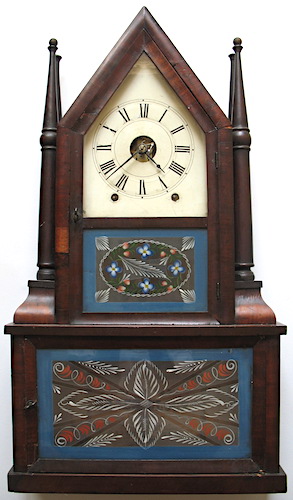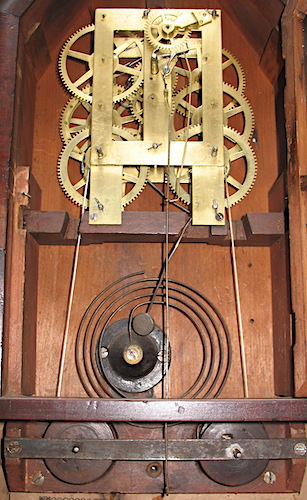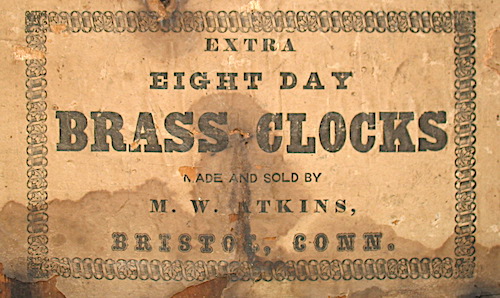For those of you who have been paying attention over the years, you’ll know that I collect almost nothing unless it has a connection to Chauncey Jerome. Some might argue that it’s an unnecessarily limiting approach to collecting, because there are so many other interesting makers to explore. Perhaps that realization was the impetus for the subject of this post, a clock purchased at the River Cities Regional earlier this year. It may be closer to the truth to say that it was a bargain I couldn’t afford to pass up. Either that, or it was my wife saying “I think we need to buy it!”
The clock is an 8-day, double fusee, time & strike, double candlestick clock made by M.W. Atkins. Merritt Atkins was involved in a number of companies, among them Atkins & Porter (c. 1840-1846), M.W. Atkins (c. 1846-1850), and M.W. Atkins & Co. (c. 1850-1856).
The type 7.1 movement is a product of the Atkins firm.
Beyond listing the name of the firm as “M.W. Atkins”, the simple label offers no clues as to period of manufacture, because there’s no printer’s line. However, the firm name is enough to date it to 1846-1850.
It’s referred to as a double candlestick because of the tapered pillars on either side of the steeple body. What’s unusual (I understand from others) is that this one has balls mounted on top of two of the candlesticks. From glue residue, it appears all four candlesticks had balls. Ones I’ve seen in books or on the internet (most of which were made by Birge & Fuller) have not had balls. Did they originally, and they’ve simply been lost over the years? These clocks all (?) came with ball or bun feet. Those are clearly missing on mine. However, there are mounting holes for feet in the base.
Going off on a tangent, the double candlestick might be regarded as a variant of the steeple-on-steeple. I’ve actually seen double candlesticks referred to as steeple-on-steeples, but I think they’re different enough to deserve their own name. The similarities are that in both there’s a rectangular lower box on which is mounted a taller and narrower box with a peaked top. The steeple-on-steeple, however, has finials mounted on plinths on both the lower box and upper box. The double candlestick (there’s also a single candlestick variant) has a pair of long, tapered finials mounted on plinths on the lower box.
The tablets, which I believe to be original, are typical of those found in other double candlesticks, whether made by Atkins or Birge & Fuller. There’s been some discussion on the NAWCC message board (starting with post #54) about the maker of the tablets. Often you’ll see one of these free-hand, geometric tablets paired with a Fenn stenciled tablet, which leads some to believe (count me among them) that they were made by Fenn’s shop. One thing that swayed me towards that viewpoint is that the color palate in paired free-hand & stenciled tablets is often identical. Is this likely if supplied by different shops?
Bringing this back around to Jerome, during the period this clock was made, Jerome wasn’t really making anything that directly competed (stylistically) with the double candlestick. The closest would have been Jerome’s oversized steeples, but I think everyone would agree that the double candlestick elevates the steeple concept to another level entirely. While I’ve always been struck by the fact that Jerome rarely passed up an opportunity to exploit a niche (high-end clocks being the biggest exception), for some reason he left this niche to other, much smaller firms.
By the way, as close-knit (even incestuous) as the CT clock-making community was, I can’t find any connection between Atkins and Jerome.


